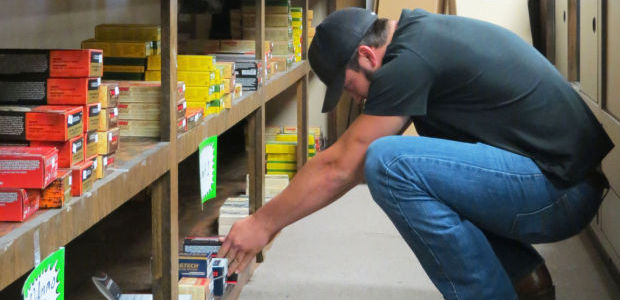
E.D. White relishes memorable baseball season
May 21, 2013
NSU grads unite for Audubon fashion fundraiser
May 21, 2013It’s 7:45 on a Monday morning. While most people are dropping off their children at school or waiting at the red light just around the corner from the office, 30 people wait patiently outside Academy Sports and Outdoors on Martin Luther King Boulevard in Houma.
It’s not a spring Black Friday event offering huge price cuts on fishing rods, lawn chairs or tennis shoes that has drawn them out this early.
These shoppers are waiting to buy bullets.
“I come out here three times a week,” said Kirk Dupre, of Houma. “I’m just looking to get stock for target practice and self-defense for my 9 mm and my .22. I’ve got a good bit, but, if it (the current shortage) stays like this, it will dwindle down.”
Dupre, one of the few in the line willing to talk, said he believes the low stock of ammunition available at stores – which limit some rounds to one box per caliber per person – is due to the increasing number of gun owners.
“There are lots of gun owners in this area, and old and new gun owners are trying to create an inventory,” he said. “I’m against any gun restrictions. I don’t believe changes will be effective against crime. It will just make it harder and more expensive for law-abiding citizens to get ammunition.”
Fellow shopper Angela Daigle, also of Houma, was in the early morning line for the first time.
“I’d been here three different times during the day, but couldn’t find the bullets for my husband’s .45 and .22,” Daigle said. “I’m shocked that this is what it’s like, having to wait in line before the store even opens to get bullets. I went to Lafayette this weekend, and the Academy there didn’t have any either. They told me to come back at 8 a.m. the next morning.”
While Dupre hoped to maintain his ammunition stockpile, Daigle was waiting to purchase rounds so she and her husband would have ammo for an upcoming concealed weapons class.
“I think Obama is just trying to take our guns away,” she said. “This shortage is politically motivated. I don’t think the people committing crimes are buying ammo. They are just stealing it from family members or friends. Buyers are responsible, and (are) going about getting ammo the legal way. That’s just my opinion.
“I’ll keep coming back until I get what I want. At least we know the people in Louisiana are protecting themselves. We are out here buying ammo.”
Others outside Academy this particular morning were familiar with the waiting process; some are regulars, arriving early each of the four days of the week the Houma Academy receives new shipments of ammunition.
“There are usually more people,” said a woman who declined to be identified. “Half of the regulars aren’t even here, and there are about 15 to 20 of them.
“I’ve been out here waiting at 6:30 a.m. before. You don’t even have to walk to the back of the store to pick up the bullets. They put them out in the front. It’s crazy that there is an ammo shortage. What good is a gun without bullets?”
“It’s hard to find re-loader equipment, too,” said a man who also declined to be identified. “It’s like a Black Friday, waiting for ammo, but better. There aren’t any fights, and it’s daylight.”
As Academy opened its doors for business, the line of customers quickly made their way to the boxes of bullets on display, made their purchases and were back in their vehicles. The whole exchange took a fraction of the time they’d spent outside waiting for the store to open.
“Across the board, we have never been able to comment on ammunition sales,” said Eric Herrera, senior communications coordinator with Academy’s corporate office, declining to answer the Tri-Parish Times’ questions.
However, Barry Songy, owner of Songy’s Sporting Goods in Houma, said he’s also experienced a high demand for ammo – especially for .22-caliber and 9 mm rounds. He keeps a waiting list and notifies customers when deliveries arrive. New shipments arrive daily from five distributors, but it still isn’t enough to keep up with demand, he said.
“We started keeping the list this January,” Songy said. “Bullets were scarce, but things are actually starting to get better. People are trying to stock up. I saw it happen four years ago, after the election. It went back to normal about six months later; so, in about another two or three months, I think it will be back to normal.”
Much like the shoppers lined up outside Academy, Songy believes the increasing number of U.S. gun owners is the cause of the ammo shortage.
“Demand is greater this time,” Songy said. “More people are buying guns these days, so more people are buying ammunition. I tell my distributors to ship whatever they have whenever they can. It’s always a surprise to see what we get, and, as soon as we get it, it’s usually out the door.
“I’m getting more in now than I was in January. All the big gun shows are in January, and that really depleted supplies. Manufacturers are working 24/7 to make ammunition.”
Until supply catches up with demand, Songy remains short on deliveries of .223-, .270-, .306- and .308-caliber rounds. And he’s limited some bullet sales to one box per person to avoid supplying the black market.
“There are people out there who want to buy a case (of ammunition) and turn around and sell it per box for a higher cost on the Internet,” Songy said. “I’m here to sell and take care of my customers.”
Conspiracy theories on the ammo shortage abound
Over the last year, as the gulf between pro- and anti-gun contingents has widened and a proliferation of gun ownership limits has been bantered about in Congress, conspiracy theorists have had plenty to say about the sudden run on ammunition. Among the theories: The real source of the problem is the federal government.
So, is the assertion grounded in fact?
Yes, says District 3 Congressman Charles Boustany Jr. (R-La.).
“The Department of Homeland Security, under the direction of President Obama, has continued purchasing millions of rounds of ammunition, taking these off of the market while producers are unable to keep up with market demand,” Boustany said in a printed statement. “This massive buy-up of millions of rounds of ammunition deserves scrutiny by Congress and by the general public.
“The Second Amendment of the United States Constitution clearly states law-abiding American citizens have a right to bear arms. This right is restricted when market shortages of ammunition impede these citizens’ ability to purchase these goods.”
Boustany has taken up the armament cause, co-sponsoring HR 1764, the Ammunition Management for More Obtainability Act of 2013. Introduced by Rep. Frank Lucas (R-Okla.), the act would limit federal agencies’ stockpile of ammunition over a six-month period to its highest level over the past 10 years.
“Until Congress has the opportunity to conduct appropriate oversight into this matter, the amount of ammunition the federal government may purchase should be capped,” Boustany’s release reads. “… I will continue to find every possible avenue to defend our Second Amendment rights.”
The DHS’ large ammunition purchases only came to light in the last month, according to Jack Pandol, Boustany’s deputy press secretary. It wasn’t the stockpile, but rather the type of bullets being purchased that has caused the congressman concern.
“DHS has been buying up hollow-point rounds; ammunition that is more expensive than full metal jacket ammunition,” Pandol said. “These types of bullets are not typically used for training, yet DHS has said it is using these rounds for training.”
Boustany is also suspect of the timing of the purchases, the spokesman said, which coincided with escalated gun-control efforts in the aftermath of the Aurora, Colo., and Newtown (Conn.) Elementary School shootings.
“Congressman Boustany has really been hearing from constituents back home in Louisiana,” Pandol said. “They are watching the news. To them, it looks like the government is trying to restrict access to ammunition. Then we find out that DHS has been buying up ammo. This bill just seems like the next logical step.”
The one-page law continues to muster support. Eighteen co-sponsors have joined Boustany’s effort, still far short of the 80 to 100 members needed to reach the markup phase. In the meantime, the Government Accountability Office – Congress’s audit, evaluation and investigative arm – is studying the buy-ups. Pandol said its findings should be made public this summer.
“People want to find out what is going on,” he said. “If the House is not satisfied with the results of the study, the Government Oversight Committee may look into the situation. The bill is a one-time measure that will limit the government ammunition purchases for six months from the day it is, hopefully, signed. It will let the market relax and allow access for the general public.
“For now we want to raise awareness about the bill and let people know what is going on.”
How much ammunition is the public buying?
Although outdoors sporting chains and ammunition manufacturers declined to provide sales numbers, the National Shooting Sports Foundation – a national firearms industry trade association based in Newtown – reports excise tax collections on firearms and ammo are at a record high.
“The increase in gun and ammo sales is a long trend,” said Michael Bazinet, NSSF’s director of public affairs. “Ammunition manufacturers are safely producing product around the clock and shipping it. It sells out quickly. It’s a consumer-driven demand. It will come back to normal. Demand will go down, and supplies will increase.”
According to NSSF figures, projected wholesale ammunition sales were $393,009 in 1991. By the close of the third quarter of 2012, that projection had risen to more than $1.37 million. The biggest projections in ammo sales were in 2009, when the total reached more than $1.56 million.
Likewise, the number of newly manufactured weapons on the market – American made and imported – has more than doubled. In 1991, NSSF numbers indicate 4.1 million guns – handguns, rifles and shotguns – were available, compared to 8.4 million in 2011.
“Reports are coming in from all over the country about ammunition shortages for a wide array of calibers,” Bazinet said. “Firearm and ammo sales are at record levels. Every month beats the record sale of the year before.”
The trend, however, does not necessarily reflect a hoarder’s fear of Armageddon, according to Bazinet. “More and more Americans are purchasing guns and ammunition for target shooting and personal defense, and women are getting more involved in shooting sports as well as self-protection.”
Geographically, the nation’s ammo shortages vary, too. Bazinet said he has heard reports of shortages among gun owners seeking a range of caliber bullets – .22, .45, .40, .357 and .38, as well as 9 mm.
“An ammunition retailer in northeast reported lines in front of their stores when they opened in the morning, too,” he said. “We don’t want to speculate on when we will see the demand go down or speculate on what is behind the ammo shortage, but we have noticed that when people become concerned with access to firearms, they respond by purchasing guns and ammo. We have seen that.”
But Bazinet is optimistic about the future for gun owners: “The shortage in all the calibers will ease, so be patient.”
Seth Nunnally, a worker at Songy’s Sporting Goods in Houma, stocks ammunition at the store. While some gun owners wait in lines outside of other ammunition stores, business owner Barry Songy keeps a waiting list for his customers.















